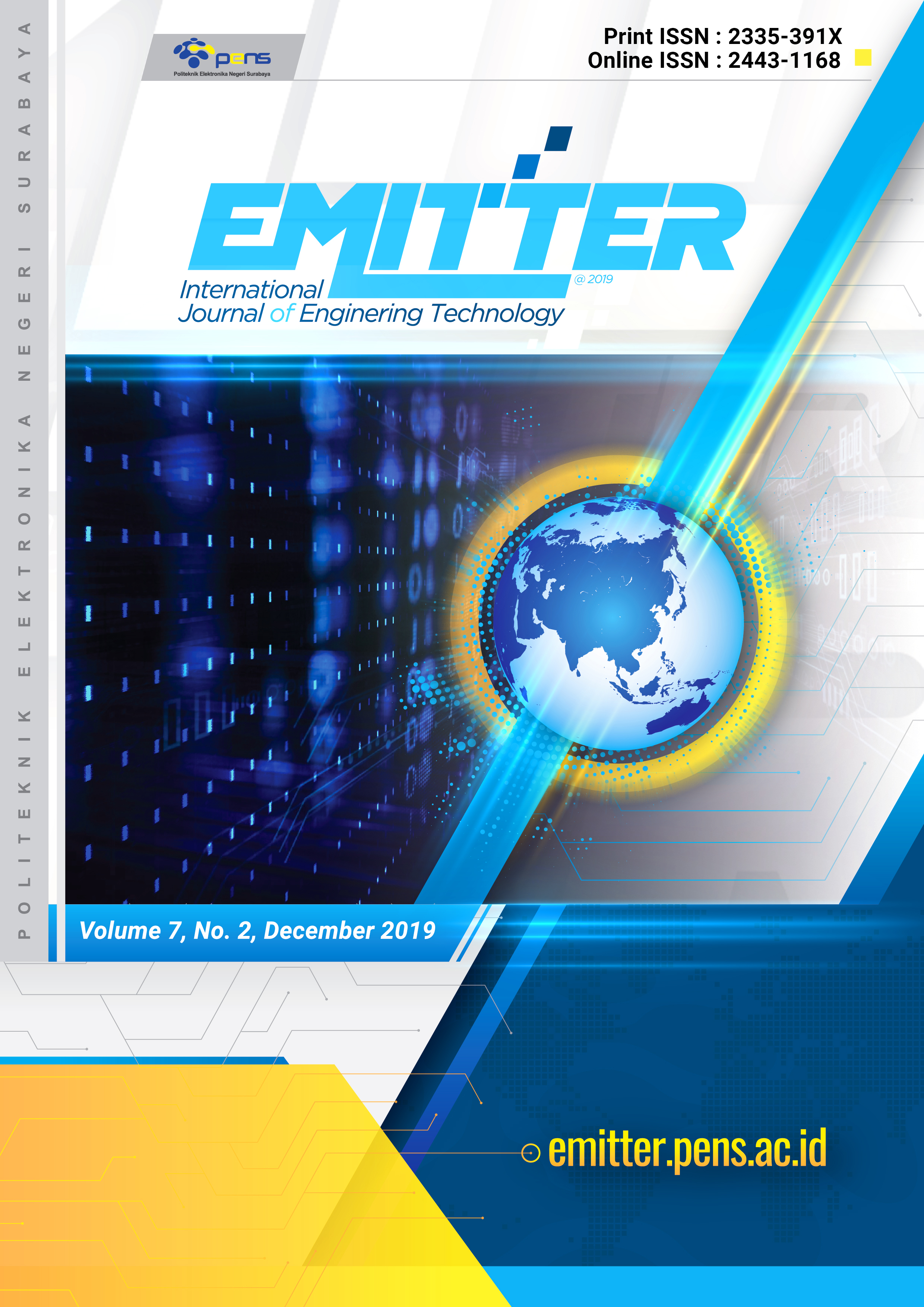Medical Image Encryption Using Modified Identity Based Encryption
Abstract
The development of technology and communication also affects the level of security needed for digital image transmission. It is known that digital images now have important meanings in both communication and video conference. In this paper, we propose a security method for medical encryption in the form of images. The proposed method is implemented in the modified Identity-Based Encryption scheme. The encryption algorithm used is Elliptic Curve Cryptography (ECC) to generate key pairs and the Advanced Encryption Standard (AES) to generate symmetric keys and encrypt process. This method has been tested based on computation time, histogram analysis and statistical analysis. The results of the test were obtained that the proposed method was resistant to multiple attacks despite having slower computing time. The proposed compute time error percentage is 1.69% for key generator stages and 0.07% for total compute time at the encrypt-decrypt stage.Downloads
References
Bruce Schneier, Applied Cryptography: Protocols, Algorithms, and Source Code in C. New York: John Wiley & Sons, 1996.
C. A. Rohmatika, “Aplikasi Keamanan Gambar dengan Kriptografi Menggunakan Algoritma AES (Advanced Encryption Standard),†Politeknik Negeri Sriwijaya, 2017.
L. D. Singh and K. M. Singh, “Medical image encryption based on improved ElGamal encryption technique,†Opt. - Int. J. Light Electron Opt., 2017.
S. H. Kamali, M. Hedayati, R. Shakerian, and Mohsen Rahmani, “A New Modified Version of Advanced Encryption Standard Based Algorithm,†in International Conference on Electronics and Information Engineering (ICEIE 2010), 2010, vol. 1, pp. 141–145. DOI: https://doi.org/10.1109/ICEIE.2010.5559902
B. Subramanyan, V. M. Chhabria, and T. G. S. Babu, “Image Encryption Based On AES Key Expansion,†in Second International Conference on Emerging Applications of Information Technology Image, 2011, pp. 217–220. DOI: https://doi.org/10.1109/EAIT.2011.60
S. M. Wadi and N. Zainal, “High Definition Image Encryption Algorithm Based on AES Modification,†Wirel. Pers Commun., vol. 79, pp. 811–829, 2014. DOI: https://doi.org/10.1007/s11277-014-1888-7
Z. Yun-peng, L. Wei, C. Shui-ping, Z. Zheng-jun, N. Xuan, and D. Wei-di, “Digital Image Encryption Algorithm Based on Chaos and Improved DES,†in 2009 IEEE International Conference on Systems, Man, and Cybernetics, 2009, no. October, pp. 474–479. DOI: https://doi.org/10.1109/ICSMC.2009.5346839
Z. Zhao and X. Zhang, “ECC-Based Image Encryption Using Code Computing,†in Proceedings of the ICCEAE2012, 2013, pp. 859–865. DOI: https://doi.org/10.1007/978-3-642-31698-2_121
A. E. Taki, E. Deen, and S. N. Gobran, “Digital Image Encryption Based on RSA Algorithm Digital Image Encryption Based on RSA Algorithm,†IOSR J. Electron. Commun. Eng., vol. 9, no. 1, pp. 69–73, 2016.
L. Li, A. A. A. El-latif, and X. Niu, “Elliptic curve ElGamal based homomorphic image encryption scheme for sharing secret images,†Signal Processing, vol. 92, pp. 1069–1078, 2012.
K. Shankar and P. Eswaran, “An Efficient Image Encryption Technique Based on Optimized Key Generation in ECC Using Genetic Algorithm,†Artif. Intell. Evol. Comput. Eng. Syst., pp. 705–714, 2016. DOI: https://doi.org/10.1007/978-81-322-2656-7_64
L. D. Singh and K. M. Singh, “Image Encryption using Elliptic Curve Cryptography,†Procedia Comput. Sci., vol. 54, pp. 472–481, 2015. DOI: https://doi.org/10.1016/j.procs.2015.06.054
G. Zhao, X. Yang, B. Zhou, and W. Wei, “Rsa-Based Digital Image Encryption Algorithm In Wireless Sensor Networks,†in 2nd International Conference on Signal Processing Systems, 2010, pp. 640–643. DOI: https://doi.org/10.1109/ICSPS.2010.5555601
T. Shahriyar, M. H. Fathi, and Y. A. Sekhavat, “An Image Encryption Scheme Based on Elliptic Curve Pseudo Random and Advanced Encryption System,†Signal Processing, vol. 141, pp. 217–227, 2017. DOI: https://doi.org/10.1016/j.sigpro.2017.06.010
D. N. Purnamasari, A. Sudarsono, and P. Kristalina, “Secure Data Sharing Scheme using Identity-based Encryption for e-Health Record,†in 2018 International Electronics Symposium on Engineering Technology and Applications (IES-ETA), 2019, pp. 60–65. DOI: https://doi.org/10.1109/ELECSYM.2018.8615549
Copyright (c) 2019 EMITTER International Journal of Engineering Technology

This work is licensed under a Creative Commons Attribution-NonCommercial-ShareAlike 4.0 International License.
The copyright to this article is transferred to Politeknik Elektronika Negeri Surabaya(PENS) if and when the article is accepted for publication. The undersigned hereby transfers any and all rights in and to the paper including without limitation all copyrights to PENS. The undersigned hereby represents and warrants that the paper is original and that he/she is the author of the paper, except for material that is clearly identified as to its original source, with permission notices from the copyright owners where required. The undersigned represents that he/she has the power and authority to make and execute this assignment. The copyright transfer form can be downloaded here .
The corresponding author signs for and accepts responsibility for releasing this material on behalf of any and all co-authors. This agreement is to be signed by at least one of the authors who have obtained the assent of the co-author(s) where applicable. After submission of this agreement signed by the corresponding author, changes of authorship or in the order of the authors listed will not be accepted.
Retained Rights/Terms and Conditions
- Authors retain all proprietary rights in any process, procedure, or article of manufacture described in the Work.
- Authors may reproduce or authorize others to reproduce the work or derivative works for the author’s personal use or company use, provided that the source and the copyright notice of Politeknik Elektronika Negeri Surabaya (PENS) publisher are indicated.
- Authors are allowed to use and reuse their articles under the same CC-BY-NC-SA license as third parties.
- Third-parties are allowed to share and adapt the publication work for all non-commercial purposes and if they remix, transform, or build upon the material, they must distribute under the same license as the original.
Plagiarism Check
To avoid plagiarism activities, the manuscript will be checked twice by the Editorial Board of the EMITTER International Journal of Engineering Technology (EMITTER Journal) using iThenticate Plagiarism Checker and the CrossCheck plagiarism screening service. The similarity score of a manuscript has should be less than 25%. The manuscript that plagiarizes another author’s work or author's own will be rejected by EMITTER Journal.
Authors are expected to comply with EMITTER Journal's plagiarism rules by downloading and signing the plagiarism declaration form here and resubmitting the form, along with the copyright transfer form via online submission.



